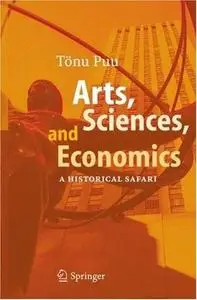Tönu Puu, «Arts, Sciences, and Economics: A Historical Safari»
Springer | ISBN 3540344233 | 1 edition (August 18, 2006) | PDF | 4.7 Mb | 193 Pages
Synopsis
The book deals with economic aspects of changing attitudes in arts and sciences. The effects of the public good character of culture, along with the very long production period and lifetime for its products, are emphasized, as both contribute to the failure of normal market solutions. Embodiment of ideas, and the consequences of modern reproduction technology for protection of property rights are focused. The evolution within arts and sciences, which often seems to return to previously scrapped ideals, is illustrated by detailed case studies, where the importance of changing tastes, rather than progress proper, is emphasized. An understanding for this is attempted by using Darwinian evolution in combination with modern mathematical complexity theory. The use of the latter is, however elementary, so no reader needs to be set back through mathematical formalism.
Table of Contents:
1 Culture and Civilization 1
1.1 Current Threats 1
1.2 Reversed Perspective 2
1.3 Civilization: Frazer 4
1.4 Embodiment 5
1.5 Specialization: Castiglione 5
1.6 Development 6
1.7 Circularity 7
1.8 Layout of the Book 7
2 Public Goods 9
2.1 The Concept 9
2.2 Embodied Ideas 10
2.3 Vivaldi's Oevre 10
2.4 Attitudes to Culture 13
2.5 Protection of Originals 17
2.6 The Marais 18
2.7 Paris and Vienna 19
2.8 Piazza San Pietro 20
2.9 Performing Arts 21
2.10 Property Rights 22
2.11 Trade Secrets 23
2.12 The Stock of Knowledge 25
2.13 Knowledge and Capital 26
2.14 Embodied Knowledge 27
2.15 Storage 28
2.16 Accessibility 29
2.17 Compactification 30
2.18 University Cultures 31
3 Patronage 33
3.1 Introduction 33
3.2 Diversity of Institutions 34
3.3 Uncertainty in Production 35
3.4 Risk and Insurance 36
3.5 Patronage in Culture 39
4 Changing Attitudes 45
4.1 Background 45
4.2 Dissipation of Culture 45
4.3 Leisure 48
4.4 Addiction 50
4.5 Dilettantism 52
4.6 Schliemann, Fermat, and Galois 53
4.7 Specialization 57
4.8 The Ultimate Purpose 57
4.9 Florence and Vienna 60
4.10 The Fin-de-Siecle 66
4.11 Nonlinearities 68
4.12 Superstars 69
4.13 Removing Constraints 70
4.14 Historical Monuments 71
4.15 Standardization 72
4.16 Concentration 73
5 Evolution in Science 77
5.1 Logical Empiricism 77
5.2 Newton, Kepler, and Galileo 78
5.3 Refutation 78
5.4 Approximate Truth 80
5.5 Ad Hoc Explanation 81
5.6 Normal Science 81
5.7 Supertheories 83
5.8 Schumpeter 83
5.9 Reductionism 84
5.10 Generalization 85
5.11 Hilbert's Programme 86
5.12 Gödel 87
5.13 Chaos and Predictability 87
5.14 Laplace 88
5.15 The Weather Factory 88
5.16 Social Engineering 89
5.17 Poincaré 90
5.18 Linearity 92
5.19 Lorenz 93
5.20 Aesthetic Principles 95
5.21 Maupertuis 95
5.22 Leibnitz 98
5.23 Metaphysics 98
5.24 Aesthetics 99
5.25 Computers and Visuality 103
5.26 Ethics 107
5.27 Pioneers 108
5.28 Pseudoscience 112
5.29 Female Scientists 114
6 Perfection in Art 117
6.1 The Role of Art in the Society 117
6.2 A Unique Opportunity 118
6.3 The Baroque Transition 119
6.4 To Romanticism 120
6.5 Musical Instruments 122
6.6 A Fast Transition 125
6.7 Discovery in Art 126
6.8 Rediscovery in Music 133
6.9 Tuning and Temperament 139
6.10 The Modern Harpsichord 141
6.11 Back to Originals 145
6.12 The Early Music Revival 148
6.13 Meaning and Beauty 150
6.14 Harnoncourt 150
6.15 Rhetoric in Music 152
6.16 Art and Science 152
6.17 Art as Sedative 155
7 Economic Principles 157
7.1 Introduction 157
7.2 Böhm-Bawerk and Smith 158
7.3 Increasing Complexity 159
7.4 The Development Tree 160
7.5 Continuous Evolution 163
7.6 Diversification 166
7.7 Property Space 167
7.8 Paretian Ordering 168
7.9 Prices and Progress 169
7.10 Branching Points 170
7.11 Music Automata 173
7.12 Bifurcations 174
7.13 Synergetics 176
7.14 Viable Alternatives 177
7.15 A "Genesis" of Musical Instruments 178
7.16 Summary 182
References 185
Illustrations 189
END



